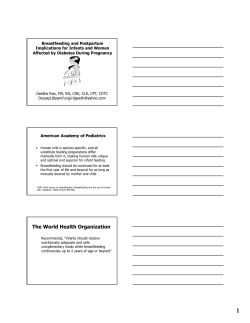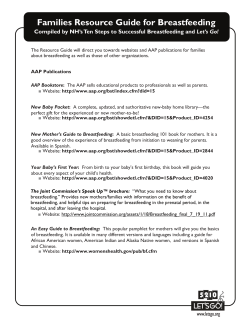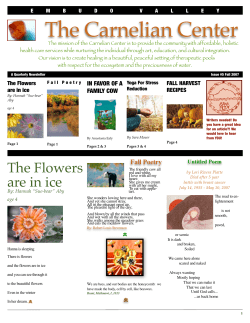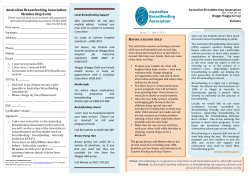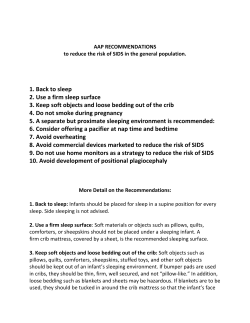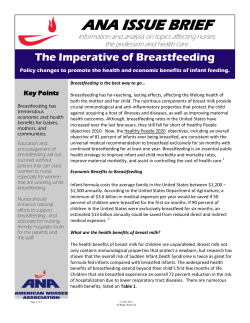
Breastfeeding and Maternal Medications Tarah Colaizy, MD, MPH
Breastfeeding and Maternal Medications Psst.. Weaning is almost never the right answer Tarah Colaizy, MD, MPH Assistant Professor of Pediatrics/Neonatology Carver College of Medicine, University of Iowa Medical Director, Mother’s Milk Bank of Iowa AAP Breastfeeding Statement http://pediatrics.aappublications.org/content/earl y/2012/02/22/peds.2011-3552 •“Breastfeeding and human milk are the normative standards for infant feeding” •“breastfeeding should be considered a public health issue and not only a lifestyle choice” •Recommends 6 months exclusive breastfeeding with continued breastfeeding for 1 year or longer Other Breastfeeding Statements • WHO: exclusive breastfeeding for 6 months, followed by continued breastfeeding for two years or longer • ACOG: “American College of Obstetricians and Gynecologists recommends that exclusive breastfeeding be continued until the infant is approximately 6 months old. A longer breastfeeding experience is, of course, beneficial. • AAFP: “infants shoulb be breastfed and/or receive expressed human milk exclusively for the first six months of life. Breastfeeding should continue with the addition of complementary foods throughout the second half of the first year. “ American Academy of Family Physicians Breastfeeding Policy Statement Breastfeeding is the physiological norm for both mothers and their children. Breastmilk offers medical and psychological benefits not available from human milk substitutes. The AAFP recommends that all babies, with rare exceptions, be breastfed and/or receive expressed human milk exclusively for the first six months of life. Breastfeeding should continue with the addition of complementary foods throughout the second half of the first year. Breastfeeding beyond the first year offers considerable benefits to both mother and child, and should continue as long as mutually desired. Family physicians should have the knowledge to promote, protect, and support breastfeeding. Breastfeeding: Infant Benefits • Infection prevention – Lower risk of otitis, lower respiratory infections, infectious diarrhea • Decreases infant mortality – 720 infant deaths in the US annually are preventable by breastfeeding • Cardiovascular protection – Lower adult blood pressure • Endocrine protection – Lower risk of diabetes – Lower risk of obesity, child and adult • Developmental optimization – IQ scores in adulthood higher in formerly breastfed Mary Cassat Breastfeeding: Maternal Benefits • Osteoporosis prevention • Cancer prevention – Uterine, breast, ovarian • Reduced post partum blood loss, quicker uterine involution • Longer inter-pregnancy interval, LAM • Lower risk of Type II diabetes among women without gestational diabetes • Lower rates of post-partum depression • Portable, cheap, clean and green Maria Pretti US Breastfeeding Rates • Initiation in the US is between 70 and 75% • Rates at 6mo are about 25%, at 12mo 12% – Fall far below Healthy People 2020 goals • Many women stop breastfeeding due to medication use – Major reason given for weaning early • 90-99% of women will take some medication post-partum But if mom is taking medicine, then so is the baby! • Yep. • Not all drugs enter milk equally, some don’t enter at all • Generally, if you’d prescribe it for a baby, its safe for the mom – Weaning for keflex or amoxicillin? • Babies are exposed to MUCH HIGHER levels of medications when administered during pregnancy, due to placental transfer – If mom was on a psych med all during pregnancy, baby is already exposed. Mom takes medication: that medication needs to be… Maternal Dose Orally available to mom Absorbed into mom’s bloodstream Able to cross into milk Orally available to baby Absorbed by baby’s GI tract Absorbed into baby’s bloodstream Infant Dose Drug Entry into Milk • Most medications penetrate into the milk compartment to some extent, typically delivering sub-clinical doses to infants • Almost always options for other medications if there is truly a concern Drug Transfer into Milk • Drugs get into milk if they: – Are highly lipid soluble – Attain high concentrations in maternal plasma – Have low molecular weight, <200kd passes easily, >500 does not – Have low protein binding (<90%) – Pass into the CNS (indicates lipophilicity) Modes of Drug Transfer • Direct Diffusion: – Mother’s plasma level most important determinent, milk level rises as maternal level rises – Milk level falls as maternal level falls, due to equilibrium – Ionic drugs can get “trapped” in milk – Human milk pH 7.0-7.2 – Drugs with pKa of <7.2 are less sequestered (pKa is the pH at which a drug is equally ionic and nonionic) Modes of Drug Transfer • Paracellular Pathway: – Big gaps between alveolar cells in first days of lactation - stuff leaks between – Larger things can get into milk, like white blood cells, larger proteins – Drugs will enter milk more during colostral phase, but overall intake is low by infant – By end of 1st week, breast starts getting smarter and junctions start to close Modes of Drug Transfer • Protein Binding: – Drugs bound to albumin are soluable in plasma – Free portion enters the milk, protein-bound stays with mom – Drugs that are highly protein bound (Coumadin), have low milk levels – Good protein binding >90% Relative Infant Dose • RID = infant’s dose via milk / (ml/kg/d) mother’s dose • Gives general idea of how much drug the infant is exposed to • RID <10% is considered safe, but even higher RID can be fine, depending on infant safety profile of medication – ie, fluconazole, metronidazole RID>20% Auguste Renoir Theoretic Infant Dose • Maximum likely dose per kg per day infant would ingest based on the peak milk level (Cmax) (if baby was getting peak conc all the time) • Based on intake of 150ml/kg/d X conc in milk • Most often, dose to infant is much lower as levels wax and wane in milk throughout the day Half Life (T 1/2) • Shorter is better • If T 1/2 is 1-3 hours, milk levels will be declining when infant feeds again • Longer T 1/2 (12-24 hrs) is less desirable, stay in plasma longer, more exposure to infant and Tmax • Shorter is better • Time from administration to maternal plasma peak • Try not to nurse during Tmax Milk/Plasma Ratio Concentration of drug in mother’s milk / Concentration in mother’s plasma • If high, 1-5, sequestered in milk • Less than 1 is preferable – However, drugs can have a higher milk/plasma ratio but a very low maternal plasma level and be completely OK Lactation Risk Scores Pregnancy risk categories not helpful L1: Safest, drug taken by large #s of nursing mothers without any increase in side effects in infants L2: Safer, drug studied in limited #s of nursing mothers without an increase in side effects in their infants L3: Moderately safe, no controlled studies in nursing mothers, risk of side effects unknown but likely minor, or studies with minor side effects. Drug should be used if maternal benefit > potential infant risk Lactation Risk Scores L4: Possibly hazardous, evidence of risk to infant or milk production, benefits to mother may be acceptable despite risk to infant (quinolones in septic mother) L5: Contraindicated, studies with significant documented risk to infant based on human experience or medication has a high risk of causing damage to infant. Risk of using drug outweighs any benefit of breastfeeding General Recommendations • Topical drugs or those ingested but not absorbed (oral vanco, etc) are not going to get to the infant • Beware of drugs with long PEDIATRIC half lives as they can build up in infants (benzodiazepines, fluoxetine, barbiturates) • Drugs that can get into milk and that cause sedation in the mom can cause sedation in the baby, increases the risk of SIDS • Pediatric approved drugs are usually a safe bet General Recommendations • Beware of drugs that affect milk supply, esp in early postpartum period (combination OCPS, mini-pill, Depo, NuvaRing, etc) – If maintenance of milk supply is very important to the mother, avoidance of all hormonal contraception is the best bet Pablo Picasso General Recommendations • Remember that if M/P is high, but Cmax low, drug is probably OK • Choose drugs with shorter half-lives • Avoid nursing at Tmax if possible • Choose drugs with higher protein binding • Choose drugs that are less lipid soluble Examples of good choices follow…. Not an exhaustive list! Safe Bets • Analgesics – Acetaminophen, codeine, fentanyl, ibuprofen, ketorolac, meperidine, methadone, morphine, propoxyphene • Antibiotics – Amox, aztreonam, cefadroxil, cefazolin, cefotaxime, cefoxitin, cefprozil, ceftazadime, ceftriaxone, clinda, erythro, gent, moxalactam, nitrofurantoin, ofloxacin, sulbactam, sulfisoxazole, tetracycline, ticarcillin, TMP/SMX Safe Bets • Anticoagulants – Warfarin, heparin • Anticonvulsants – Barbiturates, carbamazepine, ethosuximide, mg sulfate, phenytoin, valproic acid • Antihistamines – Dexbrompheniramine, fexofenadine, loratadine, terfenadine, triprolidine • Anti-thyroid – Carbimazole, methimazole, propylthiouracil Safe Bets • Anti-tubercular – Ethambutol, isoniazid, pyrimethamine, rifampin, streptomycin • Anti-viral – Acyclovir, valacyclovir • Antihistamines – Dexbrompheniramine, fexofenadine, loratadine, terfenadine, triprolidine • Anesthetics – Halothane, lidocaine, scopolamine, thiopental (moms can nurse after general as soon as they are awake and able, that means its worn off!) Safe Bets • Asthma meds – Albuterol, ipratropium bromide, montelukast, prednisone, terbutaline, theophylline, zafirlukast • Decongestants – Pseudoephedrine, ipratropium bromide • GI agents – Famotidine, omeprazole, ranitine, • Migraine – Sumatriptan, propranolol • Anti-hypertensives – Propranolol, hydrocholorothiazide, captopril, enalapril Safe Bets • Antidepressants – Amitriptyline, buproprion, paroxetine, fluvoxamine • Anti-anxiety – Alprazolam, diazepam, lorazepam • Anti-psychotic – Olanzepine, Haldol, clozapine, risperdone Mary Cassat Chemotherapy drugs • • • • Cyclophosphamide - immune supression Cyclosporine - immune supression Doxorubicin - concentrated in milk Methotrexate - immune supression Many Chemo drugs are not safe, esp taken for long periods. Hale has an excellent section on chemotherapy and breastfeeding Radioactive stuff and radiology • Maternal X rays, CT, MRI themselves don’t get to the milk • Oral contrast agents and non-radioactive IV contrast are safe • Radioactive isotopes often require pumping for periods between 0 and 24 hours, but milk can be kept for 8-10 half-lives then fed (Hale has a great section!) • Radioactive iodines are very dangerous, esp I-131, I-125, less so I-123. Cold Medicines Pseudoephedrine can significantly decrease milk supply! Guaifenesin, phenylephrine, diphenhydramine, dextromethorphan are safe Alcohol and Breastfeeding • Alcohol can inhibit the let-down reflex • Alcohol passively diffuses into the milk • Studies not convincing for harmful effects of occasional drink • Tell moms don’t nurse if you feel the effects • AAP lists it as “usually compatible,” with comment on reported effects of large amounts, e.g. drowsiness, diaphoresis, deep sleep, weakness, decrease in linear growth, abnormal weight gain Nicotine and Breastfeeding • Nicotine passes through the milk • Case reports of irritability and poor growth • Study reported increased respiratory illnesses among bottle fed infants of smoking mothers cf breastfed infants of women who continue to smoke • AAP has taken nicotine (and hence smoking) off the list of “Drugs of abuse for which adverse effects have been reported” • Advice to moms: quit or cut down, smoke outside only, have ‘smoking jacket’ Useful References • Medications and Mother’s Milk, 13th ed, Thomas W. Hale, 2008 – Best, most concise reference available, and cheap! $31 at Amazon • LactMed, http://toxnet.nlm.nih.gov/cgi- bin/sis/htmlgen?LACT – National Library of Medicine Database, excellent and well-maintained. • AAP Committee on Drugs Policy Statement, “Transfer of Drugs and Other Chemicals in Human Milk”. Pediatrics 108:3, 2001 Less Useful References • PDR - Terrible! • Drugs in Pregnancy and Lactation, Briggs. – Complicated, more focused on pregnancy, costs over $100 Take Home Message • Evaluate all the risks of the drug in relationship to the actual dose received by the infant, and the infant’s ability to handle it, before making a decision. “keep in mind the risks of formula feeding are significant and should not be trivialized” Thomas Hale Take Home Message • Interruption of breastfeeding for medication administration due to lack of proper knowledge is not acceptable. Its not trivial to the families. In most cases, breastfeeding can continue. You owe it to your patients: make an informed decision
© Copyright 2025





